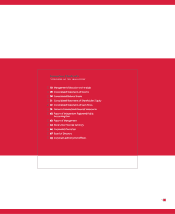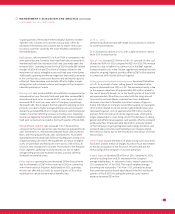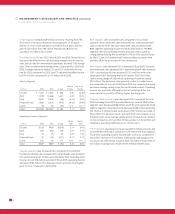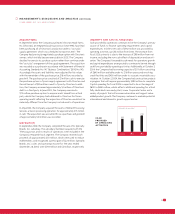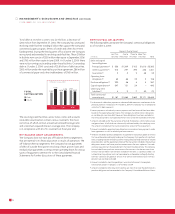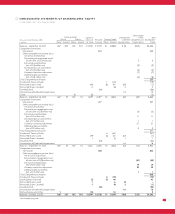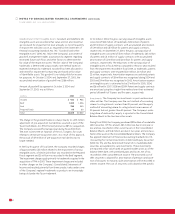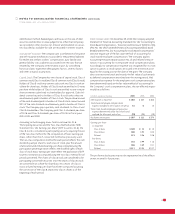Tyson Foods 2004 Annual Report Download - page 29
Download and view the complete annual report
Please find page 29 of the 2004 Tyson Foods annual report below. You can navigate through the pages in the report by either clicking on the pages listed below, or by using the keyword search tool below to find specific information within the annual report.
27
MANAGEMENT’S DISCUSSION AND ANALYSIS (CONTINUED)
Among the factors that cause actual results and experiences to
differ from the anticipated results and expectations expressed in
such forward-looking statements are the following: (i) fluctuations
in the cost and availability of raw materials, such as live cattle, live
swine or feed grains; (ii) market conditions for finished products,
including the supply and pricing of alternative proteins, and the
demand for alternative proteins; (iii) risks associated with effectively
evaluating derivatives and hedging activities; (iv) access to foreign
markets together with foreign economic conditions, including
currency fluctuations and import/export restrictions; (v) outbreak
of a livestock disease which could have an effect on livestock
owned by the Company, the availability of livestock for purchase
by the Company, or the Company’s ability to access certain markets;
(vi) successful rationalization of existing facilities, and the operating
efficiencies of the facilities; (vii) changes in the availability and rela-
tive costs of labor and contract growers; (viii) issues related to food
safety, including costs resulting from product recalls, regulatory
compliance and any related claims or litigation; (ix) adverse results
from litigation; (x) risks associated with leverage, including cost
increases due to rising interest rates or changes in debt ratings or
outlook; (xi) changes in regulations and laws (both domestic and
foreign), including changes in accounting standards, environmental
laws and occupational, health and safety laws; (xii) the ability of the
Company to make effective acquisitions, and successfully integrate
newly acquired businesses into existing operations; (xiii) effective-
ness of advertising and marketing programs; and (xiv) the effect of,
or changes in, general economic conditions.
Market risks relating to the Company’s operations result primarily
from changes in commodity prices, interest rates and foreign exchange
rates, as well as credit risk concentrations. To address certain of these
risks, the Company enters into various derivative transactions as
described below. If a derivative instrument is a hedge, as defined
by SFAS No. 133, as amended, depending on the nature of the hedge,
changes in the fair value of the instrument will be either offset against
the change in fair value of the hedged assets, liabilities or firm
commitments through earnings, or recognized in other comprehen-
sive income (loss) until the hedged item is recognized in earnings. The
ineffective portion of an instrument’s change in fair value, as defined
by SFAS No. 133, as amended, will be immediately recognized in earn-
ings as a component of cost of sales. Additionally, the Company holds
certain positions, primarily in grain and livestock futures which do
not meet the criteria for SFAS No. 133 hedge accounting. These posi-
tions are marked to fair value and the unrealized gains and losses
are reported in earnings at each reporting date. The changes in market
value of derivatives used in the Company’s risk management activi-
ties surrounding inventories on hand or anticipated purchases of
inventories are recorded in cost of sales. The changes in market value
of derivatives used in the Company’s risk management activities
surrounding forward sales contracts are recorded in sales.
The sensitivity analyses presented on the following page are the
measures of potential losses of fair value resulting from hypotheti-
cal changes in market prices related to commodities. Sensitivity
analyses do not consider the actions management may take to
mitigate the Company’s exposure to changes, nor do they consider
the effects that such hypothetical adverse changes may have on
overall economic activity. Actual changes in market prices may
differ from hypothetical changes.
The Company is a purchaser of certain commodities,
such as corn, soybeans, livestock and natural gas in the course of
normal operations. The Company uses commodity futures to reduce
the effect of changing prices and as a mechanism to procure the
underlying commodity. However, as the commodities underlying
the Company’s derivative financial instruments can experience
significant price fluctuations, any requirement to mark-to-market
the positions that have not been designated or do not qualify as
hedges under SFAS No. 133 could result in volatility in the Company’s
results of operations. Generally, contract terms of a hedge instrument
closely mirror those of the hedged item providing a high degree of
risk reduction and correlation. Contracts that are designated and
highly effective at meeting this risk reduction and correlation criteria
are recorded using hedge accounting. The following table presents
a sensitivity analysis resulting from a hypothetical change of 10%
in market prices as of October 2, 2004, and September 27, 2003,
respectively, on fair value of open positions. The fair value of such
positions is a summation of the fair values calculated for each
commodity by valuing each net position at quoted futures prices.
The market risk exposure analysis includes hedge and non-hedge
positions. The underlying commodities hedged have a correlation to
price changes of the derivative positions such that the values of the
commodities hedged based on differences between commitment
prices and market prices and the value of the derivative positions
used to hedge these commodity obligations are inversely correlated.
The following sensitivity analysis reflects an inverse impact on
earnings for changes in the fair value of open positions for livestock
and natural gas and a direct impact on earnings for changes in the
fair value of open positions for grain.


